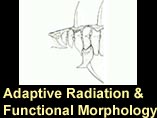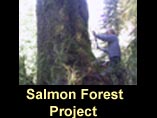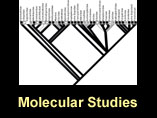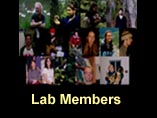Stephen Leaver, MSc candidate
email: sleaver@uvic.ca
Behavioural implications of tail
docking in Canis familiaris
The
canid tail is important for intraspecific communication. Changes in height and
motion reflect the motivational state of the signaller and provide important
cues for approaching conspecifics. The tail may be intentionally docked in up
to one third of recognized dog breeds. Some of these breeds, such as Dobermanns
and Rottweilers, have higher probability of aggressive behaviour and we suspect
that this may be facilitated by the loss of the major signalling capacity of
the tail.
 Unfortunately, differences in breed,
size, and social history make it very difficult to elucidate the behavioural
effects of one variable - tail length – in social interactions. As a
solution, Dr. Reimchen and I completed a project using an artificial and
remotely-controlled model to provide a standard stimulus with which only tail
height and motion varied. During the summer of 2006, I videotaped and
quantified the approach of 496 off leash dogs to the model when the model had
one of four tail conditions: short/still tail, short/wagging tail, long/still
tail, and a long/wagging tail.
Unfortunately, differences in breed,
size, and social history make it very difficult to elucidate the behavioural
effects of one variable - tail length – in social interactions. As a
solution, Dr. Reimchen and I completed a project using an artificial and
remotely-controlled model to provide a standard stimulus with which only tail
height and motion varied. During the summer of 2006, I videotaped and
quantified the approach of 496 off leash dogs to the model when the model had
one of four tail conditions: short/still tail, short/wagging tail, long/still
tail, and a long/wagging tail.
We found that dogs responded to
differences in tail motion of the model, not surprising given the respective
meanings of an upright still tail versus a wagging tail, but only when the tail
was long. Dogs responded similarly to the still tail model and the wagging tail
model when the model’s tail was short. We interpret this as evidence that
the different visual signals conveyed by the tail, in this case tail motion,
are  best interpreted when the tail is long. While not
directly demonstrating behavioural consequences of tail docking, this work does
provide evidence that docking a tail may impair intraspecific communication in
canids.
best interpreted when the tail is long. While not
directly demonstrating behavioural consequences of tail docking, this work does
provide evidence that docking a tail may impair intraspecific communication in
canids.
Leaver,
S.D.A. & Reimchen, T.E. (2008). Behavioural responses of Canis familiaris to different tail
lengths of a remotely-controlled life-size dog replica. – Behaviour 145:
377-390. Pdf
Behavioural ecology of Haida
Gwaii Threespine Stickleback, Gasterosteus
aculeatus
My Master’s research will focus on (1) behavioural and
(2) morphological comparisons of Gasterosteus
aculeatus from habitats differing in a variety of biophysical factors, most
specifically predation pressure.
My work began in July 2007 with the collection of
Stickleback adults and eggs from five different Haida Gwaii lakes. I have been
successful in maintaining the adults and rearing the fry at the
 For my
morphological comparisons, I will use stickleback previously collected by Dr.
Reimchen combined with high resolution digital imaging. The lab has
demonstrated population level morphological changes in response predation
pressure (see
publications). My work will specifically compare the morphology of several Haida
Gwaii populations that differ in many biophysical features, including predation
pressure. One of these, the Mayer Pond population, was started twenty years ago by transplanting stickleback
from the dystrophic
For my
morphological comparisons, I will use stickleback previously collected by Dr.
Reimchen combined with high resolution digital imaging. The lab has
demonstrated population level morphological changes in response predation
pressure (see
publications). My work will specifically compare the morphology of several Haida
Gwaii populations that differ in many biophysical features, including predation
pressure. One of these, the Mayer Pond population, was started twenty years ago by transplanting stickleback
from the dystrophic
For my non-stickleback photographs, please see my flickr website.






